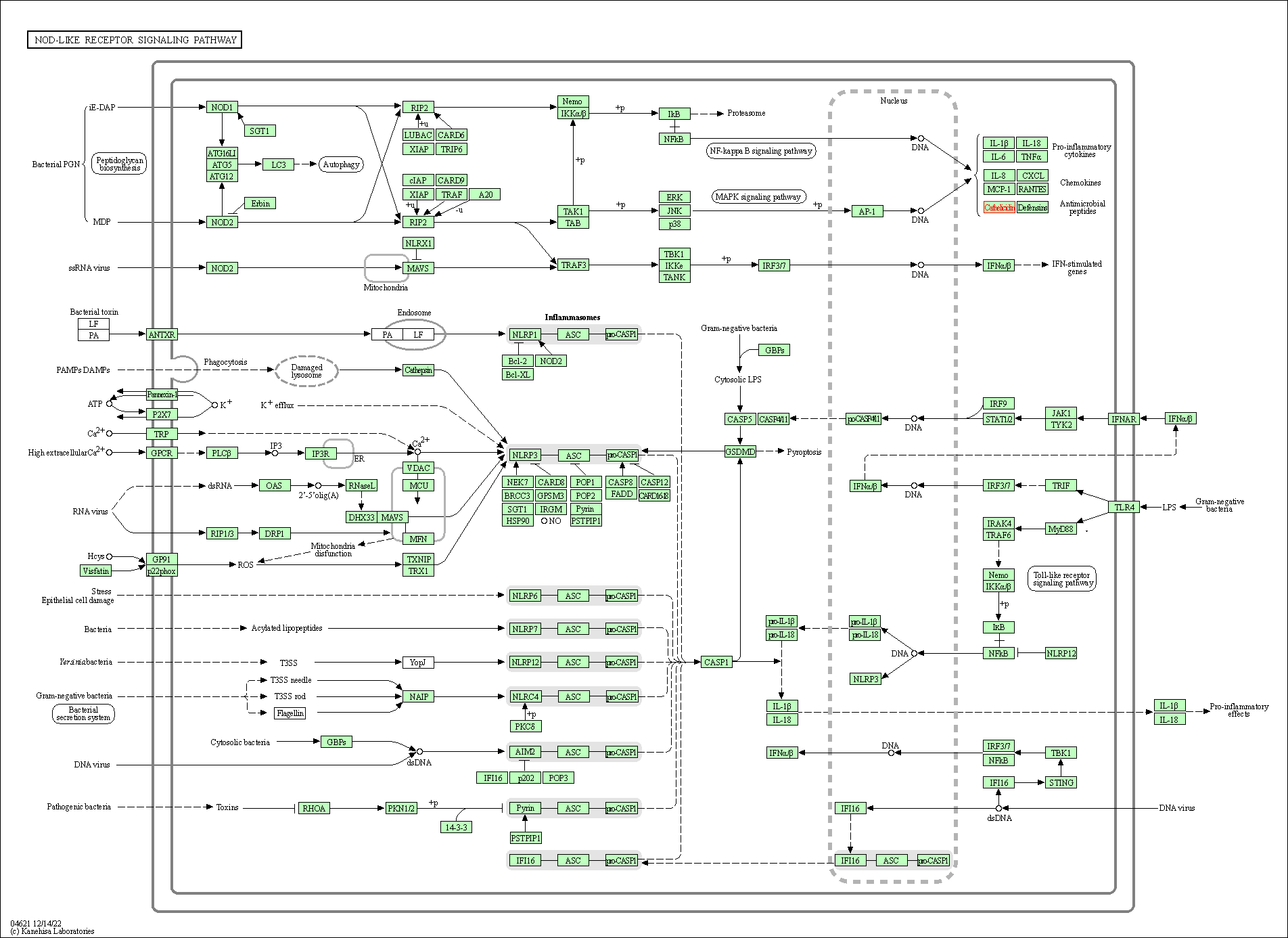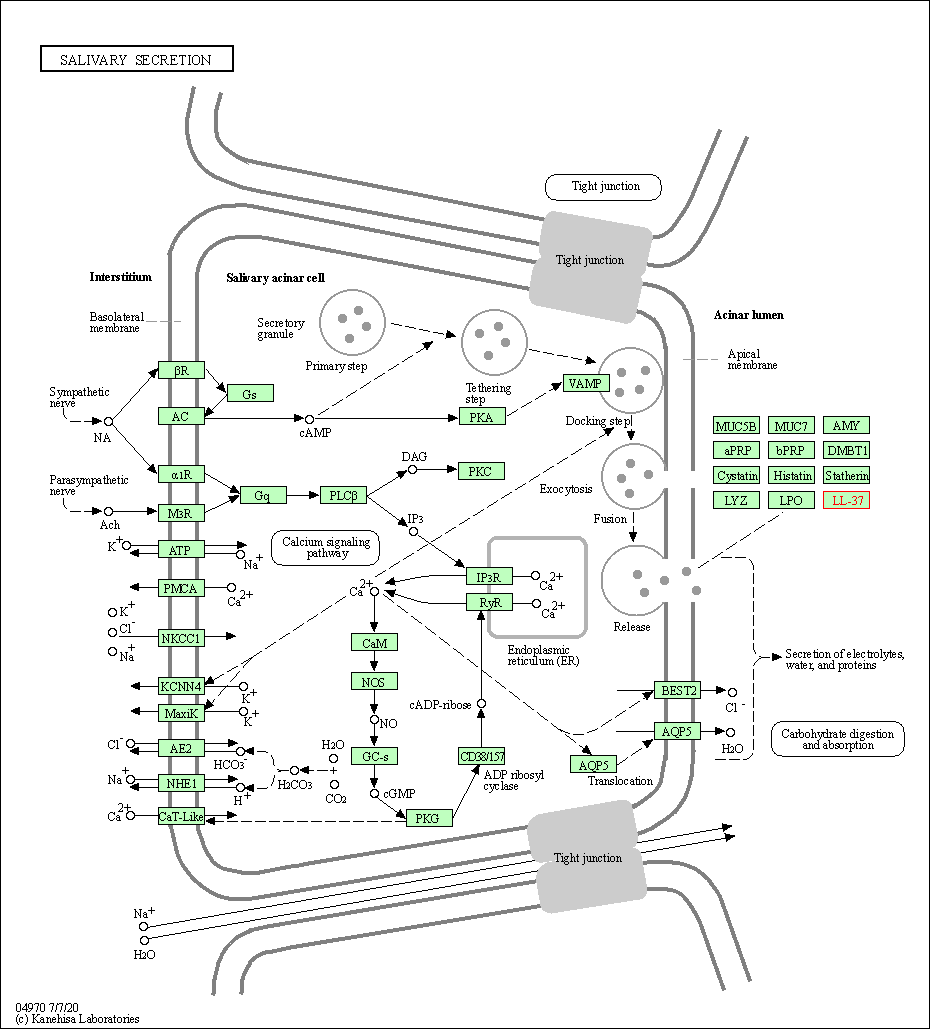Target Information
| Target General Information | Top | |||||
|---|---|---|---|---|---|---|
| Target ID |
T34318
(Former ID: TTDNS00564)
|
|||||
| Target Name |
Cathelicidin antimicrobial peptide (CAMP)
|
|||||
| Synonyms |
upregulating cAMP; hCAP18; CAP18; CAMP; Antibacterial protein LL37; 18 kDa cationic antimicrobial protein
Click to Show/Hide
|
|||||
| Gene Name |
CAMP
|
|||||
| Target Type |
Successful target
|
[1] | ||||
| Disease | [+] 1 Target-related Diseases | + | ||||
| 1 | Asthma [ICD-11: CA23] | |||||
| Function |
Binds to bacterial lipopolysaccharides (LPS), has antibacterial activity.
Click to Show/Hide
|
|||||
| BioChemical Class |
Cathelicidin family
|
|||||
| UniProt ID | ||||||
| Sequence |
MKTQRDGHSLGRWSLVLLLLGLVMPLAIIAQVLSYKEAVLRAIDGINQRSSDANLYRLLD
LDPRPTMDGDPDTPKPVSFTVKETVCPRTTQQSPEDCDFKKDGLVKRCMGTVTLNQARGS FDISCDKDNKRFALLGDFFRKSKEKIGKEFKRIVQRIKDFLRNLVPRTES Click to Show/Hide
|
|||||
| 3D Structure | Click to Show 3D Structure of This Target | AlphaFold | ||||
| HIT2.0 ID | T15URL | |||||
| Drugs and Modes of Action | Top | |||||
|---|---|---|---|---|---|---|
| Approved Drug(s) | [+] 1 Approved Drugs | + | ||||
| 1 | Colforsin daropate hci | Drug Info | Approved | Asthma | [2] | |
| Mode of Action | [+] 1 Modes of Action | + | ||||
| Modulator | [+] 1 Modulator drugs | + | ||||
| 1 | Colforsin daropate hci | Drug Info | [1], [3] | |||
| Cell-based Target Expression Variations | Top | |||||
|---|---|---|---|---|---|---|
| Cell-based Target Expression Variations | ||||||
| Drug Binding Sites of Target | Top | |||||
|---|---|---|---|---|---|---|
| Ligand Name: Lauryl Dimethylamine-N-Oxide | Ligand Info | |||||
| Structure Description | The structure of LL-37 crystallized in the presence LDAO | PDB:5NNK | ||||
| Method | X-ray diffraction | Resolution | 1.80 Å | Mutation | No | [4] |
| PDB Sequence |
LLGDFFRKSK
10 EKIGKEFKRI20 VQRIKDFLRN30 LVPR
|
|||||
|
|
||||||
| Ligand Name: Dodecylphosphocholine | Ligand Info | |||||
| Structure Description | The dimeric structure of LL-37 crystallized in DPC | PDB:5NNT | ||||
| Method | X-ray diffraction | Resolution | 2.21 Å | Mutation | No | [4] |
| PDB Sequence |
LLGDFFRKSK
10 EKIGKEFKRI20 VQRIKDFLRN30 LVPR
|
|||||
|
|
||||||
| Click to View More Binding Site Information of This Target with Different Ligands | ||||||
| Different Human System Profiles of Target | Top |
|---|---|
|
Human Similarity Proteins
of target is determined by comparing the sequence similarity of all human proteins with the target based on BLAST. The similarity proteins for a target are defined as the proteins with E-value < 0.005 and outside the protein families of the target.
A target that has fewer human similarity proteins outside its family is commonly regarded to possess a greater capacity to avoid undesired interactions and thus increase the possibility of finding successful drugs
(Brief Bioinform, 21: 649-662, 2020).
Human Tissue Distribution
of target is determined from a proteomics study that quantified more than 12,000 genes across 32 normal human tissues. Tissue Specificity (TS) score was used to define the enrichment of target across tissues.
The distribution of targets among different tissues or organs need to be taken into consideration when assessing the target druggability, as it is generally accepted that the wider the target distribution, the greater the concern over potential adverse effects
(Nat Rev Drug Discov, 20: 64-81, 2021).
Human Pathway Affiliation
of target is determined by the life-essential pathways provided on KEGG database. The target-affiliated pathways were defined based on the following two criteria (a) the pathways of the studied target should be life-essential for both healthy individuals and patients, and (b) the studied target should occupy an upstream position in the pathways and therefore had the ability to regulate biological function.
Targets involved in a fewer pathways have greater likelihood to be successfully developed, while those associated with more human pathways increase the chance of undesirable interferences with other human processes
(Pharmacol Rev, 58: 259-279, 2006).
Biological Network Descriptors
of target is determined based on a human protein-protein interactions (PPI) network consisting of 9,309 proteins and 52,713 PPIs, which were with a high confidence score of ≥ 0.95 collected from STRING database.
The network properties of targets based on protein-protein interactions (PPIs) have been widely adopted for the assessment of target’s druggability. Proteins with high node degree tend to have a high impact on network function through multiple interactions, while proteins with high betweenness centrality are regarded to be central for communication in interaction networks and regulate the flow of signaling information
(Front Pharmacol, 9, 1245, 2018;
Curr Opin Struct Biol. 44:134-142, 2017).
Human Similarity Proteins
Human Tissue Distribution
Human Pathway Affiliation
Biological Network Descriptors
|
|
|
There is no similarity protein (E value < 0.005) for this target
|
|
Note:
If a protein has TS (tissue specficity) scores at least in one tissue >= 2.5, this protein is called tissue-enriched (including tissue-enriched-but-not-specific and tissue-specific). In the plots, the vertical lines are at thresholds 2.5 and 4.
|
| KEGG Pathway | Pathway ID | Affiliated Target | Pathway Map |
|---|---|---|---|
| Neutrophil extracellular trap formation | hsa04613 | Affiliated Target |

|
| Class: Organismal Systems => Immune system | Pathway Hierarchy | ||
| NOD-like receptor signaling pathway | hsa04621 | Affiliated Target |

|
| Class: Organismal Systems => Immune system | Pathway Hierarchy | ||
| Salivary secretion | hsa04970 | Affiliated Target |

|
| Class: Organismal Systems => Digestive system | Pathway Hierarchy | ||
| Degree | 3 | Degree centrality | 3.22E-04 | Betweenness centrality | 1.02E-04 |
|---|---|---|---|---|---|
| Closeness centrality | 2.02E-01 | Radiality | 1.35E+01 | Clustering coefficient | 0.00E+00 |
| Neighborhood connectivity | 1.37E+01 | Topological coefficient | 3.33E-01 | Eccentricity | 13 |
| Download | Click to Download the Full PPI Network of This Target | ||||
| Target Profiles in Patients | Top | |||||
|---|---|---|---|---|---|---|
| Target Expression Profile (TEP) | ||||||
| Target Affiliated Biological Pathways | Top | |||||
|---|---|---|---|---|---|---|
| KEGG Pathway | [+] 2 KEGG Pathways | + | ||||
| 1 | Salivary secretion | |||||
| 2 | Tuberculosis | |||||
| Reactome | [+] 1 Reactome Pathways | + | ||||
| 1 | ROS production in response to bacteria | |||||
| WikiPathways | [+] 4 WikiPathways | + | ||||
| 1 | Vitamin D Receptor Pathway | |||||
| 2 | Latent infection of Homo sapiens with Mycobacterium tuberculosis | |||||
| 3 | Integrated Pancreatic Cancer Pathway | |||||
| 4 | SREBP signalling | |||||
| References | Top | |||||
|---|---|---|---|---|---|---|
| REF 1 | Natural products as sources of new drugs over the last 25 years. J Nat Prod. 2007 Mar;70(3):461-77. | |||||
| REF 2 | Cardiovascular and adenylate cyclase stimulating effects of colforsin daropate, a water-soluble forskolin derivative, compared with those of isoproterenol, dopamine and dobutamine. Circ J. 2002 Dec;66(12):1150-4. | |||||
| REF 3 | Natural products to drugs: natural product derived compounds in clinical trials. Nat Prod Rep. 2005 Apr;22(2):162-95. | |||||
| REF 4 | Structural remodeling and oligomerization of human cathelicidin on membranes suggest fibril-like structures as active species. Sci Rep. 2017 Nov 13;7(1):15371. | |||||
If You Find Any Error in Data or Bug in Web Service, Please Kindly Report It to Dr. Zhou and Dr. Zhang.

